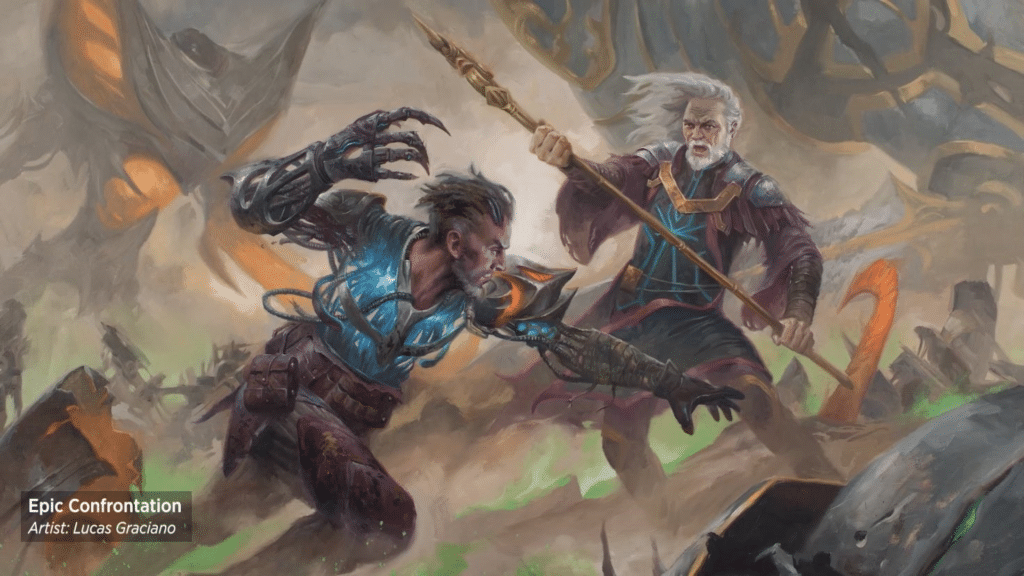It may not seem like it, but MTGRocks, as a site, has grown considerably over 2022. It’s all thanks to readers who are incredibly passionate about the MTG community, constantly tuning in to keep in touch with what’s going on every passing day. It’s also, in part, to how much more busy MTG has become since product releases started becoming more and more common.

With this growth comes some inspiring opportunities. Last week, we got the rare chance to sit down with a member of Wizards of the Coast who helped answer a few burning questions regarding the Lore and the creation of The Brothers’ War. Gavin Verhey shouldn’t need any introduction to those involved in the community, but we’ll give one anyway.
Not only was Gavin Verhey in charge of designing the eight Eternal Legal cards released alongside The Brothers’ War, but he is a longstanding design member of Wizards of the Coast and is the host of the YouTube channel Good Morning Magic! The interview focused on storytelling elements used in The Brothers’ War and how those elements intertwine with gameplay and set design.
Interview Questions with Gavin Verhey

Of all the questions we asked, this answer is the one we enjoyed the most. While the individual rarity of an MTG card has essential implications in constructed play, it also seems to herald some function in highlighting a character’s importance. Urza and Mishra at their peak, for example, are both Mythic Rare cards in The Brothers’ War. Here’s Gavin’s answer regarding the more profound implications of rarity in both a constructed play and storytelling lens:
MTGRocks: How was the rarity of cards decided for The Brothers’ War? Was it dictated by play design teams balancing around limited, or were rarities awarded based upon story merit?
Gavin Verhey: It’s kind of connected together! Generally, rarity has to do a lot with Limited gameplay and balance. And when we make some of the largest and splashiest moments of the story, those are going to be effects than are generally rare. So it tends to come together naturally: a lot of big story moments tend to get splashy designs, that end up at rare or mythic. Urza and Mishra themselves are great examples of this, seeing their young versions at uncommon and their more and more powerful versions in the story as you go up in rarity. That said, there’s plenty of big moments at common too – just look at Epic Confrontation!
Using Supplementary Product to Aid Storytelling

As writers, we find ourselves interested when Legendary Creatures or characters in MTG’s Lore appear outside the main set. Interestingly, we can still catch a glimpse of these names that have caused ripples throughout Magic’s 30 years of storytelling. To get a deeper meaning behind decision-making.
MTGRocks: Are there any moments from The Brothers’ War that you didn’t get to showcase in the primary set? Do products like Alchemy allow the Wizards of the Coast team to tell these missed stories, or are they not considered during the Alchemy design process?
Gavin Verhey: With a story as large-scale as The Brothers’ War, it’s difficult to fit everything we want into a single card set. One of the great ways we get to help show off as much as we can though is with other pieces of the set, like Alchemy which has Crucias – a character who would go on to become Bo Levar, one of Urza’s nine titans! I led the design of the Brothers War Commander Decks and getting side characters like Sanwell and Farid into them helped bring some cards that didn’t have a position in the main set to life. It’s all one story, and we’re trying to show off as much of it as we can.
If you’re interested in any of the supplementary products discussed, we have reviews for them:
- A review and upgrade guide on Mishra’s Burnished Banner
- A review and upgrade guide on Urza’s Iron Alliance
Now that supplementary product has been identified to have a secondary function in giving more characters from Magic’s Lore a physical identity, we wanted to gather more information on the decision-making process that occurs when deciding which characters would appear in the core set:
MTGRocks: Throughout the story of The Brothers’ War and Dominaria United, we met and had moments without countless characters who didn’t make it into the main set. How do you decide which characters to include and which to exclude?
Gavin Verhey: There are a ton of legends in all of these sets – and still not everybody made it! It’s a real process between the creative team and the design team. Keep in mind too that both Creative design and Set design are happening at the same time, so sometimes things are created later on in the process and there isn’t time to design a card for them. It’s a tough spot – but the good news is that if there’s a beloved character who didn’t get a card, this isn’t your only chance to see them. There are future products for us to find a home for them in.
Squeezing The Brothers’ War Story into One Set

As mentioned previously, The Brothers’ War is a massive story that spans across many years of MTG’s older sets. Considering the potential challenge of snapshotting all these stories into one set, we wanted to get a more precise lens on how this being a one-set story impacted the storytelling used when creating The Brothers’ War:
MTGRocks: Were there any significant challenges during The Brothers’ War’s design due to the set’s three-act structure? Would The Brothers’ War ideally have been a multiple-set block rather than a single premier set?
Gavin Verhey: It’s a lot of story to fit into a single set, but putting it together actually let us do a lot of cool juxtapositions. For example, seeing multiple versions of Urza and Mishra across the set at different times in their lives! The most exciting part of the Brothers’ War story tend to be the middle and end points, and it would be hard, for example, to build an entire set around the opening act – I like that we got to revisit all the cool bits of the story in a single set.
We talked previously about the three-act storytelling used when looking at spoilers from The Brothers’ War as it was getting released. Using the storytelling vehicle of Teferi glimpsing into specific points in time allows this set to showcase the most exciting moments that occurred over years of storytelling. This turned what could be a creative problem into a strength that elevated the quality of The Brothers’ War storytelling.
Which Brothers’ War Card Went Through the Most Iterations?

With the bizarre Planeswalker Karn, Living Legacy in Dominaria United comes an interesting story on how the card had to be changed at the last minute. Apparently, the previous iteration of Karn was… problematic in terms of balance. While the updated Karn is quite the opposite, the story we received alongside its reveal was fascinating. With that in mind, we wanted to ask if another card went through a similar development process in The Brothers’ War:
MTGRocks: Which Brothers’ War card went through the most iterations/changes in development? What problems did it create?
Gavin Verhey: It’s hard for me to say the most, but I know that one which lead designer Yoni Skolnik and his design team worked on a ton was getting the meld Urza and Mishra right. These are the marquee characters of the set, with a splashy returning mechanic. I think they turned out awesome!
Hats off to the design team because the Urza and Mishra Meld cards really are incredible. Even though these cards aren’t seeing a ton of competitive play, they have the largest price tags in the set for a reason.
The Modernization of The Brothers’ War

If recent events have dictated anything, it’s that modern Magic as a game and culture are very different from how it was in the past. While a revamped release schedule may be the most blatant example of this, it also shows up in storytelling aspects. Card art, for example, is one of the most important channels for communicating MTG’s Lore and evoking the creative immersion into the world that Wizards of the Coast has created. Unfortunately, as time passes, humanity may see those stories in a different light than when it was written. A recent example of this was seen when a card’s art caused it to be excluded from a recent reprinting.
Considering the discussed challenge and how much time has passed since the original telling of The Brothers’ War, we were interested if any of the original story was repurposed for modern conventions:
MTGRocks: What were your biggest challenges when trying to modernize The Brothers’ War Story? How did this impact the retelling of the story in this set?
Gavin Verhey: We wanted to be totally authentic to the source material, while also viewing it through the lens of today and with decades of reflection. For example, Urza may have been seen as a hero when the story was originally written – he’s certainly no good guy, and we get into his many sides here. Similarly, this is a brutal war and we wanted to make sure how gritty it could get in the card set. We didn’t really want to retcon anything – but we did pick places to expand on where we felt it was appropriate. I’m really happy with how it turned out, and hats off to our Creative team for all their hard work!
Time Travel as a Storytelling Device in Magic

Time Travel is a pretty popular vehicle used to tell some unique stories throughout fictional history. With 30 years of history, and a lot of major backstory-related events that have not been told in detail, there is a lot of potential in visiting events whispered amongst characters in modern storytelling. When asking Verhey about using this storytelling vehicle more, this is what he had to say:
MTGRocks: Time travel has created a new opportunity to explore past events in various planes. What past event (besides The Brothers’ War) would you be the most interested in exploring in a future set? Assume anything is on the table, no matter how unlikely!
Gavin Verhey: I’m a huge sucker for Time Travel stories. This should come as no surprise given that one of my favorite shows is Doctor Who – I led the design of our Doctor Who Commander decks, so stay tuned for those. There’s a lot of great stories to go back to, but I know I personally would like to see Alara! What happened there? What caused Alara to sunder into five separate worlds? Maybe someday we’ll find out!
What Happens Next?

Honestly, when asking this question, we realized that we weren’t likely to get much of an answer. That said, The Brothers’ War ended on a huge cliffhanger, and we couldn’t help taking a shot in the dark. If you’re interested in reading about Teferi’s glimpse into The Brothers’ War yourself, you can check it out on the official MTG site!
MTGRocks: With the epilogue of The Brothers’ War’s story ending on such a cliffhanger, we have to ask. What’s going on with Teferi? Where are they now?
Gavin Verhey: You’ll just have to keep reading the story to find out. 🙂
Read More: MTG’s Most Expensive Collectible Priced at $2.5 Million


